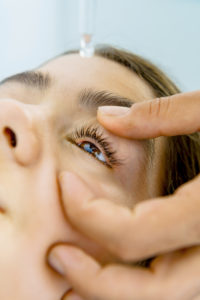sponsored content
November 1, 2023
By Erin S. Tomiyama, OD, PhD, FAAO
Most compounding pharmacies are small and do not have the capability to routinely test their product in the same manner as commercial drug manufacturers are required to do. Ultimately, this raises a public health concern about the quality, stability, and sterility of the low-dose atropine that is being distributed and used.

The prescription of low-dose atropine is on the rise as it is becoming the most common pharmaceutical treatment for slowing myopia progression in children. In the U.S., low-dose atropine must be obtained directly from a compounding pharmacy. These pharmacies differ from commercial drug manufacturers, which are held to strict guidelines by the Food and Drug Administration (FDA), in that they do not have to undergo the same rigorous testing of their products. These more lenient requirements may cause concern about the final product that is dispensed by the compounding pharmacy. Eye care providers, patients, and parents may all question if the low-dose atropine obtained from compounding pharmacies is safe and effective for use.
Comparing Low-Dose Atropine from Compounding Pharmacies
These concerns led researchers to try and understand the compounding practices of 0.01% atropine from various compounding pharmacies across the U.S.1 Through a survey of 26 different compounding pharmacies across 19 states, they found a wide variety of responses in terms of packaging, recommendations, and product composition. Most pharmacies recommended storing the low-dose atropine at room temperature, but 38% recommended refrigeration. The median bottle size was 5 ml, which is approximately a 50-day supply with nightly bilateral use, and the median beyond-use date was 65 days (IQR: 45-158 days).
The product’s composition also varied amongst pharmacies, with half using commercially available 1% atropine, 38% using powdered atropine, and 8% using either (depending on availability) to prepare their product. Inactive ingredients added to the starting compound can affect the stability of the final product. Artificial tears (42%) and saline (23%) were the most commonly added ingredients. Preservatives can affect the sterility of the final product. Commercially available 1% atropine often contains benzalkonium chloride (BAK). When diluted to lower the concentration, the preservatives are also diluted to the point that they may be ineffective in maintaining the product’s sterility.
Samples of 0.01% atropine were then acquired from nine different compounding pharmacies and analyzed 30 days after receipt.2 Most ophthalmic solutions have a neutral pH (6.6-7.8) to mimic natural tears, but atropine is stable at lower pH levels (2-4), which may cause stinging or discomfort upon instillation. At higher pH levels, atropine breaks down faster into tropic acid, which has no antimuscarinic properties. The median pH of the samples was 6.9, and samples from two pharmacies had tropic acid concentrations that were higher than the U.S. Pharmacopeia (USP) limit, indicating instability of the product.
The median concentration of atropine after 30 days was 93%, but six samples had less than 90% of the target. The concentration should be within 10% of the labeled or prescribed concentration. Since these samples were 0.01% atropine, which is the lowest prescribed concentration, the lower measured concentration poses a concern for the efficacy of the product.
Since the procedures of compounding pharmacies vary dramatically, it is unlikely that there is consistency of product from one location to another. Even within one compounding pharmacy, the product is often made in small batches allowing for potential inconsistencies between orders. Most compounding pharmacies are small and do not have the capability to routinely test their product in the same manner as commercial drug manufacturers are required to do. Ultimately, this raises a public health concern about the quality, stability, and sterility of the low-dose atropine that is being distributed and used.
Why Are There No Commercially Available Options?
With the growing use of low-dose atropine for myopia management and the concerns about products obtained from compounding pharmacies, practitioners may wonder why there is no commercially available option. For any ophthalmic product, there are several critical quality attributes that must be met in order to gain FDA approval. Manufacturers must consider how the drug is administered, how long it stays on the eye, how it gets absorbed, if it causes any irritation upon application, and several other factors that contribute to the stability, sterility, and efficacy of the final product.
One factor to consider is the product’s viscosity or the drop’s thickness. If the product’s viscosity is too similar to the tear fluid or water, it may become diluted, decreasing its efficacy. With a greater viscosity, the product may have a greater residence time (meaning it would sit longer on the eye). However, if the product is too thick, it can cause unwanted side effects such as blurry vision, irritation, or difficulty in administration. The inactive ingredients used to dilute the atropine will also affect the overall viscosity. Saline, for example, would reduce the viscosity, whereas adding polymers or sugars would increase the viscosity.
Another consideration is the pH of the product. As mentioned previously, the ocular surface is close to neutral, so any difference in pH may cause irritation or stinging. Ideal ophthalmic products are close to neutral or slightly acidic, since more basic could damage tissues. However, at a neutral pH, atropine is unstable and will degrade quickly, reducing its concentration and efficacy. Buffers can be added to stabilize the pH of the solution throughout its shelf life.
Lastly, there are several limitations and requirements regarding the packaging or container in which the drug is stored. It should be a user-friendly bottle that can easily dispense one drop at a time. Manufacturers must be cognizant of the container material as it could contain chemicals that could leach into the drug product, especially over a long shelf life. The container must also be able to withstand different stressors, such as varying temperatures and humidity levels.
Due to the size of compounding pharmacies, there are obvious limitations to their ability to produce a consistent product that meets the rigorous testing of the FDA. Therefore, there is a clear need for the development of a commercially manufactured, FDA-approved product. This development would allow practitioners, parents, and patients to feel confident in the stability, sterility, and potential efficacy of the final low-dose atropine product. While there are many considerations for developing a commercial product and several criteria that must be met to gain FDA approval, there is a hope that practitioners will soon be able to prescribe low-dose atropine with confidence that their patients are receiving a safe and effective product.
 |
Dr. Erin Tomiyama is an Assistant Professor of Optometry at Marshall B. Ketchum University. She received her OD degree from the Southern California College of Optometry at Marshall B. Ketchum University. Dr. Tomiyama completed a Cornea and Contact Lens Residency at the University of Houston College of Optometry. During residency, she was introduced to clinical research and decided to pursue a MS, then PhD, in Physiological Optics. In her current role, Dr. Tomiyama teaches in the Contact Lens curriculum and serves as a clinical attending in the Stein Family Cornea & Contact Lens Center. She has developed a passion for myopia management and recently established the Myopia Management Service at the university. Her research areas of interest are myopia, optics, contact lenses, and astigmatic corrections. Dr. Tomiyama is a fellow of the American Academy of Optometry and a two-time Ezell Fellowship recipient. |
This article is sponsored by Vyluma.
References:
- Richdale K, Tomiyama ES, Novack GD, Bullimore MA. Compounding of Low-Concentration Atropine for Myopia Control. Eye & Contact Lens: Science & Clinical Practice. 2022;48(12):489-492. doi:10.1097/ICL.0000000000000932
- Richdale K, Skidmore K V., Tomiyama ES, Bullimore MA. Compounded 0.01% Atropine-What’s in the Bottle? Eye Contact Lens. 2023;49(6):219-223. doi:10.1097/ICL.0000000000000990













